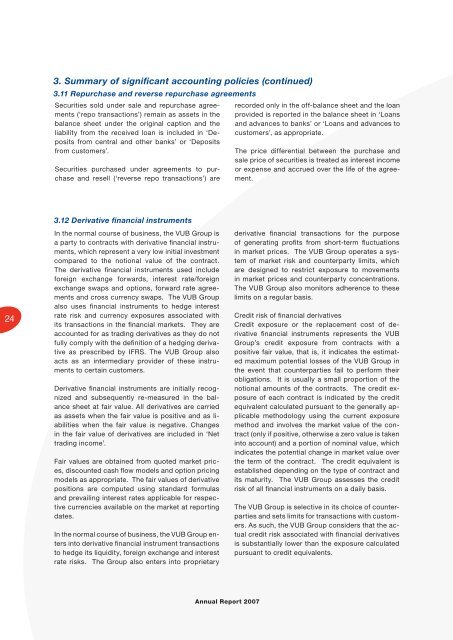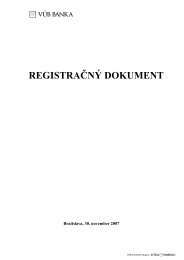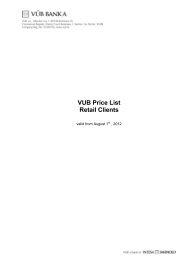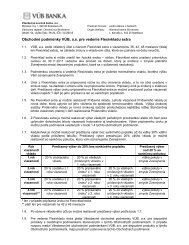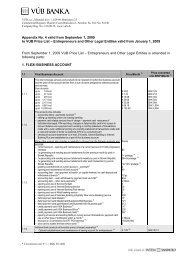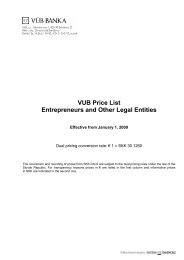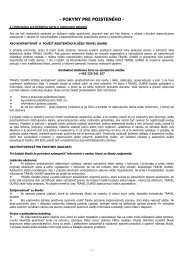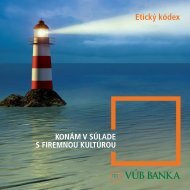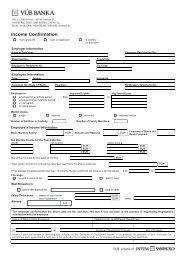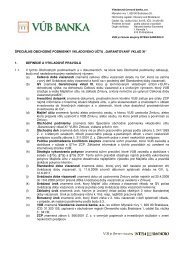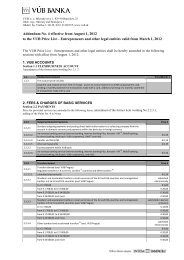Annual Report - VÃB banka
Annual Report - VÃB banka
Annual Report - VÃB banka
You also want an ePaper? Increase the reach of your titles
YUMPU automatically turns print PDFs into web optimized ePapers that Google loves.
3. Summary of significant accounting policies (continued)<br />
3.11 Repurchase and reverse repurchase agreements<br />
Securities sold under sale and repurchase agreements<br />
(‘repo transactions’) remain as assets in the<br />
balance sheet under the original caption and the<br />
liability from the received loan is included in ‘Deposits<br />
from central and other banks’ or ‘Deposits<br />
from customers’.<br />
Securities purchased under agreements to purchase<br />
and resell (‘reverse repo transactions’) are<br />
recorded only in the off-balance sheet and the loan<br />
provided is reported in the balance sheet in ‘Loans<br />
and advances to banks’ or ‘Loans and advances to<br />
customers’, as appropriate.<br />
The price differential between the purchase and<br />
sale price of securities is treated as interest income<br />
or expense and accrued over the life of the agreement.<br />
24<br />
3.12 Derivative financial instruments<br />
In the normal course of business, the VUB Group is<br />
a party to contracts with derivative fi nancial instruments,<br />
which represent a very low initial investment<br />
compared to the notional value of the contract.<br />
The derivative fi nancial instruments used include<br />
foreign exchange forwards, interest rate/foreign<br />
exchange swaps and options, forward rate agreements<br />
and cross currency swaps. The VUB Group<br />
also uses fi nancial instruments to hedge interest<br />
rate risk and currency exposures associated with<br />
its transactions in the fi nancial markets. They are<br />
accounted for as trading derivatives as they do not<br />
fully comply with the defi nition of a hedging derivative<br />
as prescribed by IFRS. The VUB Group also<br />
acts as an intermediary provider of these instruments<br />
to certain customers.<br />
Derivative fi nancial instruments are initially recognized<br />
and subsequently re-measured in the balance<br />
sheet at fair value. All derivatives are carried<br />
as assets when the fair value is positive and as liabilities<br />
when the fair value is negative. Changes<br />
in the fair value of derivatives are included in ‘Net<br />
trading income’.<br />
Fair values are obtained from quoted market prices,<br />
discounted cash fl ow models and option pricing<br />
models as appropriate. The fair values of derivative<br />
positions are computed using standard formulas<br />
and prevailing interest rates applicable for respective<br />
currencies available on the market at reporting<br />
dates.<br />
In the normal course of business, the VUB Group enters<br />
into derivative fi nancial instrument transactions<br />
to hedge its liquidity, foreign exchange and interest<br />
rate risks. The Group also enters into proprietary<br />
derivative fi nancial transactions for the purpose<br />
of generating profi ts from short-term fl uctuations<br />
in market prices. The VUB Group operates a system<br />
of market risk and counterparty limits, which<br />
are designed to restrict exposure to movements<br />
in market prices and counterparty concentrations.<br />
The VUB Group also monitors adherence to these<br />
limits on a regular basis.<br />
Credit risk of fi nancial derivatives<br />
Credit exposure or the replacement cost of derivative<br />
fi nancial instruments represents the VUB<br />
Group’s credit exposure from contracts with a<br />
positive fair value, that is, it indicates the estimated<br />
maximum potential losses of the VUB Group in<br />
the event that counterparties fail to perform their<br />
obligations. It is usually a small proportion of the<br />
notional amounts of the contracts. The credit exposure<br />
of each contract is indicated by the credit<br />
equivalent calculated pursuant to the generally applicable<br />
methodology using the current exposure<br />
method and involves the market value of the contract<br />
(only if positive, otherwise a zero value is taken<br />
into account) and a portion of nominal value, which<br />
indicates the potential change in market value over<br />
the term of the contract. The credit equivalent is<br />
established depending on the type of contract and<br />
its maturity. The VUB Group assesses the credit<br />
risk of all fi nancial instruments on a daily basis.<br />
The VUB Group is selective in its choice of counterparties<br />
and sets limits for transactions with customers.<br />
As such, the VUB Group considers that the actual<br />
credit risk associated with fi nancial derivatives<br />
is substantially lower than the exposure calculated<br />
pursuant to credit equivalents.<br />
<strong>Annual</strong> <strong>Report</strong> 2007


